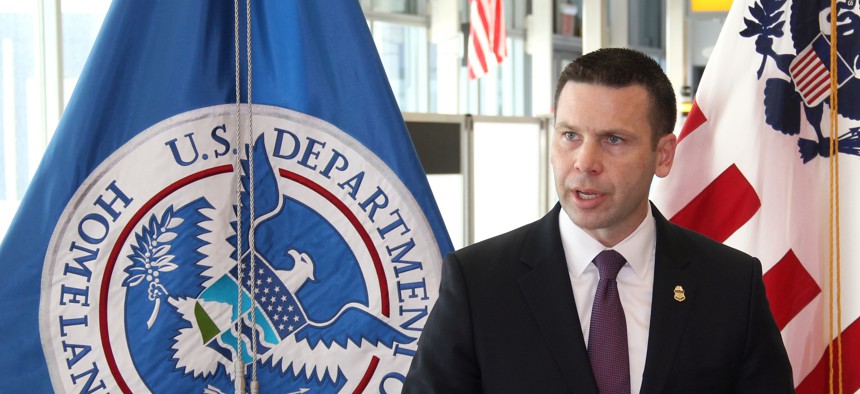
Kevin K. McAleenan, who is now acting secretary of the Department of Homeland Security, speaks in New York City in 2018. U.S. Customs and Border Protection
DHS’s New Counterterrorism Strategy Reflects Professionalism, Not Politics
The counterterrorism experts who oversaw the Obama-Trump policy transition applaud the new strategy’s bold approach to domestic terrorism and guns.
It’s become commonplace to lament how even national security has become politicized. The notion that partisan politics stops at the water’s edge—meaning before the government’s formulation and execution of foreign policy and national security policy—has given way to a sense that America’s divisions have spread even to the defense of our nation. That makes it even more important to applaud when our government delivers a document that exceeds expectations and reflects not politics but strategy.
That’s what the two of us — former White House senior counterterrorism officials — see in the new Strategy for Countering Terrorism and Targeted Violence, released today by the Department of Homeland Security.
Our respect for a professional, apolitical approach to national security—and, in particular, counterterrorism—comes from firsthand experience. As civil servants in government, we coordinated White House counterterrorism policy during the transition between the Obama and Trump administrations. Amid a sometimes fractious transition, we were proud to see an interagency counterterrorism community that stuck doggedly to its critical mission of keeping Americans safe from terrorist threats, undaunted and undistracted by politics.
Almost one year ago, the Trump administration released a lucid National Strategy for Counterterrorism—the first document of its kind since 2011—which serves as a comprehensive blueprint for confronting a range of terrorist threats, now and into the future. Both of us had left the White House by then, yet we cheered a strategy that reflected genuine counterterrorism expertise rather than politics. The question, as one of us noted at the time, was how much that strategy would actually get implemented.
Related: Trump Removes Top DHS Staff
Related: DHS Wants to Collect More Social-Media Records
Related: Trump’s Border Obsession Is Courting Disaster
That’s where today’s document released by DHS comes in. It shows that one vital part of the federal government’s counterterrorism apparatus is taking seriously the implementation of the administration’s national strategy.
Consider its treatment of domestic terrorism, a topic that Trump’s earlier document had, to its credit, described as “a persistent security threat.” The new DHS strategy notes “a concerning rise in attacks by individuals motivated by a variety of domestic terrorist ideologies, including white supremacist violent extremism.” What’s more, DHS accurately places this escalating, increasingly transnational threat in a global context that ensures key lessons from almost two decades of efforts against jihadist international terrorism can be brought to bear.
The new strategy also addresses another oft-politicized national security challenge: the danger posed by firearms. Noting that most of the mass attacks in public spaces in 2018 were committed with such weapons, DHS rightly calls attacks by firearms and other weapons (such as drones) against pre-selected targets—what the department calls “targeted violence”—as a national security challenge in and of itself, regardless of whether those attacks are driven by a terrorist ideology. It underscores the danger posed by the easy availability of firearms, a point long made by the likes of ISIS, which encourages U.S.-based followers to acquire and use guns in attacks on American soil. It recognizes non-terrorist “targeted violence” as a growing phenomenon, and as more than a series of standalone tragedies. And it echoes and entrenches in a U.S. government strategy what former Chairman of the Joint Chiefs of Staff Mike Mullen wrote last month: that assault weapons, in particular, pose a “growing national-security threat.”
All told, the new document delivers on the promise of President Trump’s own counterterrorism strategy while vowing that the U.S. government’s approach will “evolve with the threat.” Attacks motivated by white supremacist terrorism are increasing. By emphasizing this rising threat, situating it in the context of a growing transnational white supremacist movement, confronting the dangers posed by firearms in the hands of terrorists, and addressing “targeted violence” as its own form of national security threat, DHS’s strategy reflects an important evolution in terrorism and other violence targeted against civilians.
Consider October 2017. On the first day of that month, a lone shooter killed 58 people from a Las Vegas hotel window. On the last day of the month, a jihadist ran down pedestrians and cyclists on a Manhattan bike path, killing eight. These two attacks — a mass killing of indeterminate motivation, a smaller-scale attack inspired by jihadist ideology — show the rise of new kinds of national security threats. DHS’ new document represents a U.S. government counterterrorism and targeted-violence strategy that moves in important ways beyond a post-9/11 focus on jihadism—and provides a welcome reflection of serious strategy rather than partisan politics.
NEXT STORY: It’s Really Hard to Buy Peace in Afghanistan



